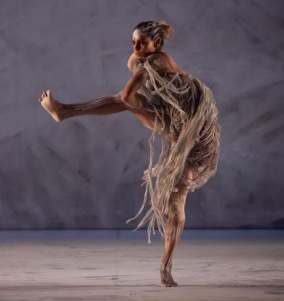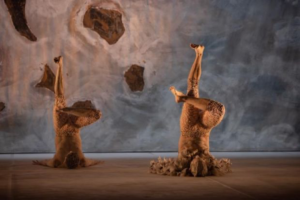Bangarra Dance Company. Drama Theatre, Sydney Opera House. 9 – 25 June, 202
Reviewed : 10 June, 2022*

The wide, open stage of the Drama Theatre is Kati Thanda (Lake Eyre). Lightning flashes across a stark white stage and thunder crashes and echoes invoking this vast, changing landscape of desert and salt pans that are magically transformed by the run-off of monsoon rains. Set designer Jacob Nash and lighting designer Karen Norris come together to recreate the dramatic vagaries and colours of this place that has been the home of the Arabunna people for thousands of years.
Kati Thanda is their Terrain. They have “read the landscape … known its purpose”, cared for it and worked within its cycles for generations. Arabunna elder Uncle Reg Dodd’s stories of his Country are re-told through a contemporary perspective in Bangarra’s Terrain.

First performed in 2012, this intricately contrived piece of theatre returns after 10 years because, as choreographer and artistic director Frances Rings explains, “There has been an increase in concern around the management of environments, and more research into Indigenous ways of understanding Country … That knowledge is powerful and valuable”.
Terrain explores that knowledge in nine inspiring dance sequences performed to an evocative score composed by creative maestro David Page. Rings describes it thus: “David was able to bring the vision to life on another level. It’s a score that carries you to Country … through his sonic architecture”.

Sixteen highly skilled dancers move to that sonic architecture to conjure the terrain of Kati Thanda and the corresponding culture of the Arabunna people. They do so in choreography that accentuates the features that are so distinctly characteristic of our indigenous dance culture; movements that curve and flow close to the land or reach up high above it. Movements that combine ancient symbols with contemporary variation. That convey messages in ways that are discretely and intrinsically unique.
In Red Brick the dancers hear the ancestral Calling to Country that takes them via a complex manipulation of Shields, that symbolises the struggle for land rights and recognition to be Reborn through knowledge and customs among the Spinifex around Lake Eyre. Salt signifies an “abstract landscape that resonates with ancient power” and Scar the disruption inflicted by man on nature. Landform symbolises regeneration and healing leading them to Reflect on a new horizon that brings a rejuvenating Deluge of transformation and hope.

The colours of the landscape are replicated in the costumes made from woven fabrics that pick up the varied tones of the desert terrain – lovely sandy beiges, rusty browns, light chartreuse and vivid blues that are reflected in the painted images of the landscape that frame the stage.
The nine inter-connected sequences of Terrain trace the history of the Kati Thanda – and in doing so tell the story of the wider Terrain that is Country. It’s a potent piece of theatre told powerfully, perceptively – brilliantly brought back to the stage as the government makes its pledge to the Uluru Statement form the Heart and a First Nations Voice to Parliament.
Terrain will be in the ACT at Canberra Theatre Centre from 28 – 30thJuly, and moves to the Queensland Performing Arts Centre from 4 -13th August.
Also published in Stage Whispers magazine
*Opening Night